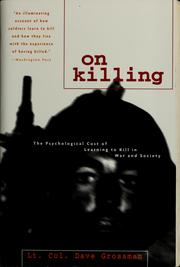Check nearby libraries
Buy this book

The good news is that most soldiers are loath to kill. But armies have developed sophisticated ways of overcoming this instinctive aversion. And contemporary civilian society, particularly the media, replicates the army's conditioning techniques, and, according to Lt. Col. Dave Grossman's thesis, is responsible for our rising rate of murder among the young. Upon its initial publication, On Killing was hailed as a landmark study of the techniques the military uses to overcome the powerful reluctance to kill, of how killing affects soldiers, and of the societal implications of escalating violence. Now, Grossman has updated this classic work to include information on 21st-century military conflicts, recent trends in crime, suicide bombings, school shootings, and more. - Publisher.
Check nearby libraries
Buy this book

Previews available in: English
Subjects
Combat, Homicide, Military Psychology, Psychological aspects, Psychological aspects of Combat, Psychological aspects of Homicide, Psychological aspects of Violence, Psychology, Military, Social aspects, Social aspects of Violence, Violence, Psychology, Tötung, War, Krieg, Militärpsychologie, Armed Conflicts, Psychologie, Fremder Feind, Mord, War and society, Violence, psychological aspects, Psychological warfareShowing 2 featured editions. View all 11 editions?
| Edition | Availability |
|---|---|
|
1
On killing: the psychological cost of learning to kill in war and society
2009, Little, Brown and Co.
in English
- Rev. ed.
0316040932 9780316040938
|
zzzz
Libraries near you:
WorldCat
|
|
2
On Killing: The Psychological Cost of Learning to Kill in War and Society
1996, Little, Brown
in English
- 1st pbk. ed.
0316330116 9780316330114
|
aaaa
Libraries near you:
WorldCat
|
Book Details
Table of Contents
Edition Notes
Originally published: 1995.
"Back Bay books."
Includes bibliographical references (p. [348]-352) and index.
Classifications
The Physical Object
ID Numbers
Source records
Excerpts
Links outside Open Library
Community Reviews (0)
Feedback?History
- Created October 16, 2008
- 14 revisions
Wikipedia citation
×CloseCopy and paste this code into your Wikipedia page. Need help?
| April 4, 2024 | Edited by OL-00 | Edited without comment. |
| December 5, 2022 | Edited by ImportBot | import existing book |
| May 2, 2022 | Edited by dcapillae | full title and subtitle |
| September 17, 2021 | Edited by ImportBot | import existing book |
| October 16, 2008 | Created by ImportBot | Imported from Oregon Libraries MARC record |
















